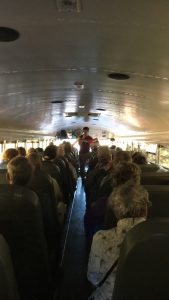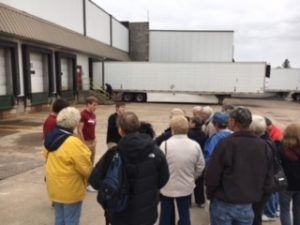When it comes to visualizing cranberry farming, the iconic Ocean Spray commercials often come to mind. But while the two actors provide a nice glimpse into the cranberry industry, it’s nothing compared to a Wisconsin FFA chapter’s agritourism cranberry venture. After all, it’s getting worldwide recognition.
Some might say the Pittsville FFA has perfected the old game of show and tell with their Splash of Red Cranberry Tour. Eighteen years ago, the FFA chapter’s cranberry program offered five tours and totaled 60 guests. Since then, the tours have grown in numbers, often averaging over 75 guests per tour. In 2017 alone, the chapter entertained more than 1,000 guests.
“Our students have hosted and been exposed to people from every state in the nation, countries of Germany, Japan, Canada, and Australia, as well as Governor Doyle and our State Representative Amy Sue Vrwink in past years,” said Lindsay Meissner, Pittsville Agricultural Education Teacher and FFA Advisor. “We have tour guests from all over the world now. Observing students grow in this education process from the first tour to the last is a rewarding and educational experience.”
An initiative started by local FFA Alumni members and the agricultural education instructor, the Splash of Red Cranberry Tour offers a comprehensive and interactive look at a cranberry operation, giving students an opportunity to teach what they’ve learned in class and practice public speaking and leadership skills while boosting local tourism.
The program is completely run by the students who are enrolled in the course for the current term. A script is developed for the different parts of the tours and students then practice and perfect it … all before the last week of September.

“The students are involved in every level of the tours, from the opening assembly, to the various stops along the tour and then finally, the students serve a Wisconsin-based cranberry infused meal option for the tour guest,” Meissner said. “As the teacher, I am there to help organize and facilitate the students, but the students are truly the ones that offer the interactive experience for our tour guest.”

The 2 1/2 hour guided tour held every Wednesday and Friday during the month of October includes:
- Observation and explanation of current marsh construction.
- Explanation of 1-3 year marsh (it takes 4 years for a marsh to start full production).
- Demonstration of integrated pest management and honeybee importance to growing cranberries.
- Discussion regarding a working cranberry marsh (in which the tourists get off the bus and pick fresh cranberries).
- Observation of the cranberry harvest in progress.
- Discussion while the cranberries are being washed and dispersed at the cleaning station.
- Tour of the working cranberry lab and explanation of the “premium berry” requirements.
- Demonstration of the “binning” and freezing of the berries.
A cranberry-based lunch served by Pittsville students wraps up the tour. Each guest then leaves with fresh cranberries, juice, and craisins.
While the tourists walk away with a deep appreciation and understanding of cranberry farming, it’s the Pittsville students that reap the most.
“I do have students interesting in continuing in the cranberry industry. I have also spoken to former students, who are currently in the industry and have moved back to the area and now are managing or owning cranberry operations,” Meissner said. “We just began our scheduling process for next year, and I have many graduating seniors that promote the benefits, uniqueness, and exciting experience that this class offers to our students at Pittsville High School.”
Meissner said a few Pittsville students that are in the cranberry industry have also begun SAE programs this year. The chapter hopes to grow the SAE cranberry science program in the future.
Meissner encourages other FFA chapters to consider exploring specialty crop and livestock production in their programs and the world of agritourism.
“Exploring our local agricultural industries gives a value to the world of agriculture and its contributions to our American way of life. It is crucial that a strong and influential agriculture program continues to meet the needs of our daily lives, both locally and nationwide,” Meissner said. “Agriculture cannot stop in the classroom. Agriculture students have the ability to influence their communities by giving back to the towns that helped them to grow into the young adults they are today.”



